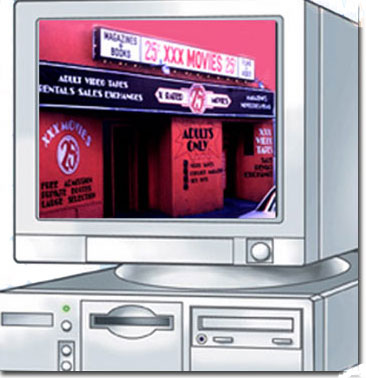
© 2004, UrbisMedia
One of the ways we make complex phenomena more understandable and familiar is to compare them with human traits and characteristics. Take cities. For example, we ascribe personality characteristics to them, such as a “pushy” New York, “bawdy” San Francisco, “sedate” Charleston, “sensuous” Paris, etc. We also liken parts of cities to human biological systems: downtowns are referred to as the “hearts” of cities, open spaces as “lungs,” streets comprise the “circulation” system, implying not only that cities have similar characteristics as we humans, but also that it is somewhat “natural” that they have them.
Like people, cities also possess a feature that is accorded less metaphorically reference than these others—“the erogenous zone.” And, like people, cities are often less at ease with this zone than they are with their hearts, lungs and circulation systems. The erogenous zones of cities are those districts or areas in which are to be found, often juxtaposed, such so-called “adult” land uses as “X-Rated” movie theatres, peep shows, pornography book stores, massage and “rap” parlors, baths, and nude dancing bars, often with pimps, prostitutes and drug pushers in between.
Since the first cities some 10,000 years ago almost all have had an erogenous zone or zones, even the great religious cities. In fact, there were times in urban history when the line between the “sacred” or temple district and the “profane” or extra-temple area, was quite vague. Indeed, there were places where the temple and the brothel had the same address. Over various periods, and in various places, urban erogenous zones they have been permitted or proscribed, persecuted or tolerated. Like other land uses in cities, they would not have continued to exist had they not served some social purpose or need, whether those purposes were considered by some to be socially acceptable or not.
In recent times, partly because of the resurgence of religious fundamentalism, the spread of sexually-transmitted diseases, and because of the spread of adult land uses beyond the confines of inner city grey areas, city officials have come under increasing pressure to “do something” about the erogenous zones of American cities. Many citizens would prefer to see them banished from their municipalities, but the U.S. Supreme Court has already ruled that, however much it may seem to attenuate the concept, adult land uses fall under the protection of “freedom of speech and expression.” While this decision has the effect of legalizing the erogenous zones it does not leave them free of regulation, since the court’s ruling does allow cities to protect nearby areas from potential deleterious impacts of x-rated land uses.
City planners and lawyers have come up with some ways the appease those who fear their cities will need to change their names to Sodom or Gomorrah. One approach, employed in Boston, was to create a zone and restrict any adult land uses to that zone, prohibiting them anywhere else. The other, first used in Detroit, forbad adult land use to locate nearby schools, residential areas and churches. These approaches have been upheld in the courts and the Detroit approach has been much copied.
They seem to have worked in many places. Urban erogenous zones have been shrinking and many of their land uses dying out. Propriety seems to be returning to our cities. So what will become of the erogenous zones, which cities have had for thousands of years? Have methods been found to eliminate them for once and all? Probably not. Will cities that do eliminate them lose convention business? Maybe. Will pornography and sex crimes disappear along with them? Very unlikely.
Perhaps the biggest threats to the erogenous zones of cities are not from outraged citizens, the clergy, or zoning ordinances. X-rated videos and home VCRs, and most recently the Internet, with its vast array of pornographic we sites have already spelled the demise of many adult movie houses and peep shows. Any pornography or paraphernalia that an adult book stores and sex shops used to offer can be mail-ordered, and; out-call massage, escort and entertainment services provide the real thing for those still undaunted by the threats of venereal diseases and AIDS. Paradoxically, these developments may be turning theresidential areas of our cities into the primary locations of X-rated land uses. It seems that cities will continue to have erogenous zones in one form or another—as long as people do.
___________________________________
©1988, ©2004, James A. Clapp (UrbisMedia Ltd. Pub. 3.5.2004)
Based on Radio Essay No. 25, aired, KPBS Public Radio, April 8, 1988
